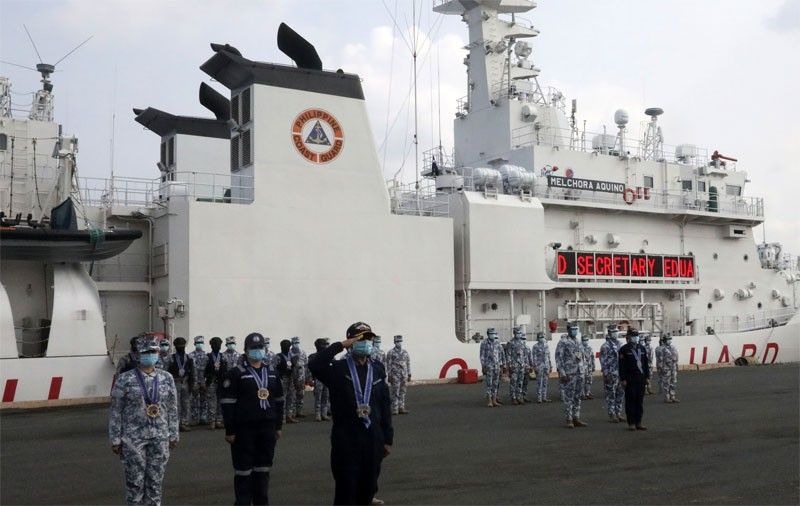‘Navy can help coast guard install buoys in West Philippine Sea’

MANILA, Philippines — As more navigational buoys are needed to mark the country’s maritime borders, the Philippine Coast Guard (PCG) may turn to the Philippine Navy for help in installing more of them in the West Philippine Sea (WPS), according to a lawmaker.
“The Coast Guard should install more buoys in the entire breadth of the WPS, from the northern part of the country in the Ilocos region to the south in the Palawan area, because that is the extent of Philippine territorial waters China is claiming,” Cagayan de Oro City Rep. Rufus Rodriguez, chairman of the House committee on constitutional amendments, said yesterday in a statement. “Coast Guard could also seek the help of the Philippine Navy in placing the buoys.”
Meanwhile, National Security Adviser Eduardo Año said the country needs more navigational buoys aside from the 10 installed recently by the PCG.
“I earnestly hope that the PCG continues to deploy buoys in other maritime features in the WPS throughout the remainder of your term,” Año said, addressing Coast Guard Commandant, Admiral Artemio Abu.
Año was guest of honor at ceremonies at the PCG headquarters welcoming the return of 317 coast guard personnel who installed five of the buoys.
Rodriguez said the markers “should serve as a warning to the Chinese and other foreign intruders that those are a demarcation of our 200-mile EEZ (exclusive economic zone) under international law.”
“China should leave that area. They have no business occupying certain islets and sea features there,” Rodriguez said, as he commended the PCG leadership for placing five new navigational buoys in areas in the West Philippine Sea coveted by China.
The Mindanao lawmaker said the PCG should procure more buoys and that funding for the acquisition of the markers should be included in its budget proposal to the Department of Budget and Management and Congress.
According to reports, the PCG installed markers carrying the national flag in five areas near the Spratly Islands group off Palawan, including Julian Felipe Reef, also known as Whitsun Reef, last month.
In March 2001, the government protested the presence of more than 200 Chinese vessels around Julian Felipe Reef, which is about 175 miles from the Palawan town of Bataraza, or well within the country’s 200-mile EEZ.
About half of the ships left after the filing of the protest. A year later, the Department of Foreign Affairs again sent Beijing a diplomatic note complaining about the continued presence of Chinese vessels in the vicinity of Julian Felipe Reef.
Rodriguez said the PCG should also place buoys near Bajo de Masinloc, also called Panatag or Scarborough Shoal, which is about 120 miles from Zambales and Pangasinan and a traditional fishing ground of Filipino fishermen from the two provinces.
“That is clearly part of our EEZ, and yet China is occupying it. The Chinese Coast Guard routinely harass our fishermen there,” he said.
China seized Panatag Shoal in 2012 after a standoff between the Chinese Coast Guard and the Philippine Navy.
Sovereign markers
“Let us show that we are promoting and supporting safe, peaceful and free navigation. But more than that, we are serious and determined in protecting and defending our right, territory and sovereignty,” Año said.
Aside from serving as sovereign markers, the buoys are also floating aids to navigation that direct fishermen and passing vessels to safe passage.
“President Ferdinand Marcos Jr. has made it clear that he will not allow any foreign power to take even an inch of our territory, and the guidance he provides is resolute. I am certain that the Commandant of the PCG along with the 26,400 coast guardians have answered his call with patriotic fervor,” said Año.
“This act of marking the boundaries with our national flag signals our unwavering resolve to safeguard our aquatic borders and resources. Furthermore, it underscores our adherence to global statutes, specifically the United Nations Convention on the Law of the Sea, which acknowledges coastal states’ entitlement to manage their EEZs,” he added.
He praised the coast guard for vigorously performing its task “not based on brute force but rather buttressed by international and domestic laws.”
Just last month, a Chinese coast guard vessel nearly collided with PCG vessel BRP Malapascua in the vicinity of Ayungin Shoal.
Earlier, also near the Ayungin Shoal, a Chinese coast guard vessel reportedly directed a military-grade laser light at a PCG vessel.
“Indeed, it is a very challenging time to conduct maritime patrol in our seas and guarantee the safety and welfare of our nation and our people, yet you courageously sail and wade through the risky and troubled waters with your duty and mission burning brightly across the horizons,” Año said in praise of PCG personnel.
“Especially amid an increasingly volatile West Philippine Sea and in the face of continued aggressions and threatening acts, PCG stood its ground as a reliable patroller in our territory – safeguarding our country and our people’s interests, territorial integrity, sovereignty, sovereign rights and jurisdictions,” he said.
The setting of the markers went on, not without harassment from the Chinese.
PCG spokesman Rear Admiral Armand Balilo said a Chinese coast guard ship was tailing the PCG vessel as it was laying the fifth navigational buoy near Julian Felipe Reef. He said the Chinese ship was some two nautical miles from the PCG vessel.
At a briefing yesterday, PCG Maritime Safety Services Command head Vice Admiral Joseph Coyme said the service launched air patrol to check the location of the 20 buoys. He admitted there had been “radio challenges” from the Chinese which, he admitted, could not be avoided “because of the proximity of the claimed or occupied territories such as Pag-asa Island and Subi Reef.”
Subi or Zamora Reef is occupied by China and is reportedly just 26.5 kilometers from Pag-asa Island, which is occupied by Filipinos. – Evelyn Macairan, Jose Rodel Clapano
- Latest
- Trending






























